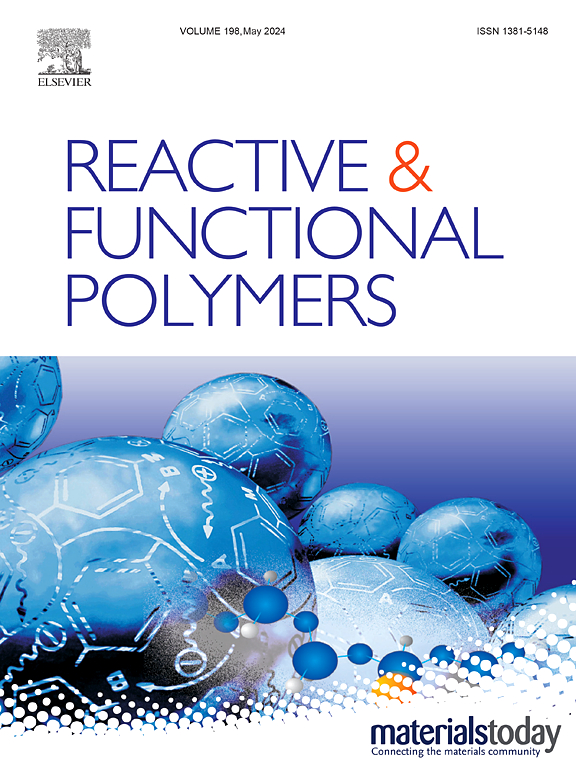蔬菜包装用聚己二酸丁二酯/咖啡酸复合材料的研制
IF 4.5
3区 工程技术
Q1 CHEMISTRY, APPLIED
引用次数: 0
摘要
聚己二酸丁二酯(PBAT)由于其良好的防水性能而被广泛用作生物塑料。本研究以氯仿为溶剂,采用溶剂铸造法,将PBAT与咖啡酸(CA) (1-3 wt%)进行溶液混合。紫外可见光谱结果表明,PBAT/3CA的透光率从100%下降到6%。随着CA比的增加,薄膜的伸长率明显提高,达到1055.4%。此外,加入CA (3 wt%)后,拉伸强度显著提高,达到25.5 MPa。PBAT/3CA的水蒸气渗透性(WVP)为3.05±0.1 × 10−11 g.m/m2.Pa.s,水接触角(WCA)为60.5°±1.34°。含有3wt % CA的PBAT膜对ABTS•+和DPPH•具有明显的清除作用,记录值分别为100%和98.5%。对大肠杆菌(E. coli)和单核增生李斯特菌(L. monocytogenes)等食源性致病菌进行了抑菌试验,结果表明所制备的薄膜具有良好的抑菌活性。含有PBAT/CA的活性膜具有作为食品包装的协同解决方案的潜力,结合了PBAT的紫外线阻隔性能、机械性能、柔韧性、抗剥皮性和著名的生物降解性,以及重新利用工业废物的能力。本文章由计算机程序翻译,如有差异,请以英文原文为准。

Formulation of poly(butylene adipate-co-terephthalate)/caffeic acid composites for vegetable packaging applications
Poly(butylene adipate-co-terephthalate) (PBAT) is widely used as a bioplastic owing to its commendable water-barrier properties. In this work, PBAT was blended with caffeic acid (CA) (1–3 wt%) by solution mixing using chloroform as a solvent through solvent casting method. UV–Visible spectroscopy results show a decrease in transmittance from 100 % in PBAT to 6 % PBAT/3CA. The film's elongation was notably improved with an increase in the CA ratio, reaching up to 1055.4 %. Moreover, the tensile strength experienced a significant enhancement upon the inclusion of CA (3 wt%) up to 25.5 MPa. The decrease in water vapor permeability (WVP) (3.05 ± 0.1 × 10−11 g.m/m2.Pa.s) and water contact angle (WCA) (60.5° ± 1.34°) was observed in PBAT/3CA. PBAT film containing 3 wt% CA exhibited remarkable scavenging action against ABTS•+ and DPPH•, recording values of 100 % and 98.5 %, respectively. When subjected to testing against foodborne pathogens such as Escherichia coli (E. coli) and Listeria monocytogenes (L. monocytogenes), the fabricated films displayed excellent antibacterial activity. The active films comprising PBAT/CA possess the potential to serve as a synergistic solution for food packaging, combining the UV barrier property, mechanical properties, flexibility, peeling resistance, and renowned biodegradability of PBAT with the ability to repurpose industrial waste.
求助全文
通过发布文献求助,成功后即可免费获取论文全文。
去求助
来源期刊

Reactive & Functional Polymers
工程技术-高分子科学
CiteScore
8.90
自引率
5.90%
发文量
259
审稿时长
27 days
期刊介绍:
Reactive & Functional Polymers provides a forum to disseminate original ideas, concepts and developments in the science and technology of polymers with functional groups, which impart specific chemical reactivity or physical, chemical, structural, biological, and pharmacological functionality. The scope covers organic polymers, acting for instance as reagents, catalysts, templates, ion-exchangers, selective sorbents, chelating or antimicrobial agents, drug carriers, sensors, membranes, and hydrogels. This also includes reactive cross-linkable prepolymers and high-performance thermosetting polymers, natural or degradable polymers, conducting polymers, and porous polymers.
Original research articles must contain thorough molecular and material characterization data on synthesis of the above polymers in combination with their applications. Applications include but are not limited to catalysis, water or effluent treatment, separations and recovery, electronics and information storage, energy conversion, encapsulation, or adhesion.
 求助内容:
求助内容: 应助结果提醒方式:
应助结果提醒方式:


